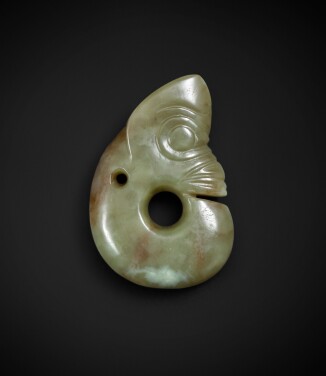S otheby’s Asian art sale on 10 June includes a fine selection of Chinese ceramics, Buddhist sculptures and works of art from French and other European collections, amongst them two iconic examples of Chinese ceramics: a beautiful white-glazed Tang dynasty ‘amphora vase’, exhibited at the Currier Gallery of Art, Manchester, New Hampshire in 1959, from the collection of Mr. and Mrs. Eugene Bernat (1896-1982), and a rare and exceptionally large guan-type archaistic vase, seal mark and period of Yongzheng, from an old French Estate, which had been mounted as a lamp since the end of the 19th century.
The sale features several private collections, including an important collection of Chinese art comprising huanghuali furniture, archaic jades and stone statuaries acquired from Moreau-Gobard and at the French Paris Biennale since the 1970s, an important collection of early jades, assembled by a European collector from the late 80s to the 90s, and a large French private collection of Buddhist statuary, scholarly items and bronze vessels from the Rhône valley.

The sale features several great examples of Chinese Ceramics spanning over ten centuries of China's dynastic history, among them an iconic white-glazed ‘amphora’ vase from the Bernat collection, and an exceptional ‘Guan’- type archaistic hexagonal vase from the Yongzheng reign. A crisply carved and finely glazed auspicious celadon jar from the Yuan-early Ming dynasties, a pair of Kangxi period underglaze blue and red ‘floral’ bowls and two rare doucai Yongzheng period ‘lozenges and medallion’ dishes further highlight this section.

Assembled in Paris since the 1970s through regular acquisitions from prominent dealers or at the Paris Biennale, this collection include a fine cabinet in Huanghuali from the late Ming – Early Qing dynasty, a splendid archaistic jade cong acquired from Jean-Claude Moreau-Gobard in 1978, and a rare fragmentary relief stone head from the 7th century.

The sale features a rare European collection of early Jades from the Neolithic period, Hongshan culture. Hongshan jades are distinctive in style, characterized by superbly polished, very smooth, softly rounded surfaces that appeal to the haptic sense. They include both figurative and abstract items, and the features on the former and the decoration on the latter are equally indicated in a highly subtle manner, sometimes only through slight changes of the surface plane or through shallow, raised or grooved lines, that can be felt, but are often visible only at close inspection, when turning the piece in the light. The Hongshan culture mixed the agricultural toolkit and iconography of the Northern Heilongjiang and Yellow River cultures that gradually moved and welded together to lay the foundation of the iconography of the Bronze Age, giving us a fascinating insight into the development of a very early but distinct artistic idiom in China.

The section of the sale dedicated to the arts of India and South East Asia includes several fine examples of stone statuary, all previously exhibited or published and preserved in old private European collections, including an extraordinary large head of Devi, North India, 9th-10th century, a grey sandstone torso of a female divinity in the Baphuon style, circa. 11th century, and a rare 17th-18th marble sculpture of Nandi from Rajasthan.

A fine group of archaic bronze ornament and horse bridle pieces from the Eastern Zhou dynasty to the Han dynasty, an exquisitely inlaid Yuan-Ming dynasties archaistic bronze buffalo inkwell and numerous examples of later Chinese bronze from the late Ming to the Qing dynasties encapsulate the emblematic quality of bronze metalwork over the centuries in the decorative arts of China.

Since the introduction of Buddhism, images of Buddha and bodhisattva were believed to be imbued with the spiritual presence of the deity they depicted, and served as bridges between the deity and devotees. It was under the Tang dynasty that Buddhism reached its most flourishing phase. The years of cultural and political division that accompanied dynastic changes from the fall of the Han through the establishment of the Sui and Tang dynasties, gradually led to the rise of Pure Land Buddhism. From the early years of the Tang dynasty, Buddhism was supported by the Imperial court, who actively sponsored major building projects and encouraged monks to travel abroad and bring back sacred scriptures, financing temples and monastic stops along the pilgrimage roads.

Finally, the quality of the decorative arts produced under Imperial patronage at the Qing court is demonstrated by several examples of jade and cloisonné, and a superb inlaid zitan-framed table screen.




































